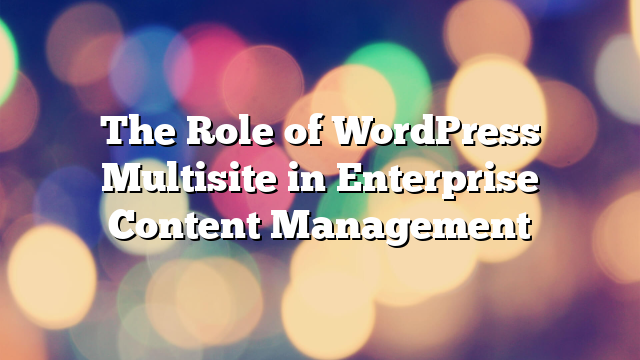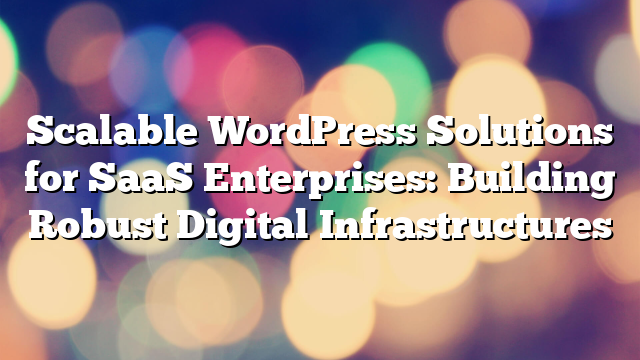The Role of WordPress Multisite in Enterprise Content Management
30.11.2024

For enterprises managing multiple websites, maintaining consistency, efficiency, and scalability is a significant challenge. WordPress Multisite offers a powerful solution, enabling businesses to run multiple websites from a single WordPress installation. By centralizing content management and streamlining workflows, enterprises can achieve greater control and efficiency. In this article, we’ll explore how WordPress Multisite can revolutionize content management for enterprises and help them meet their unique needs.
What is WordPress Multisite?
WordPress Multisite is a feature that allows users to create and manage multiple websites under a single WordPress installation. Each site operates independently, with its own themes, plugins, and content, but all are managed from a unified dashboard. This makes Multisite ideal for enterprises with diverse content needs, such as international branches, subsidiary brands, or regional websites.
Benefits of WordPress Multisite for Enterprises
1. Centralized Management
With WordPress Multisite, enterprises can manage multiple websites from a single dashboard. This simplifies tasks such as updating themes and plugins, monitoring performance, and maintaining security across all sites.
2. Consistent Branding
Maintaining brand consistency across multiple websites is critical for enterprises. WordPress Multisite allows centralized control over themes and branding elements, ensuring a unified look and feel across all platforms.
3. Cost and Resource Efficiency
Running a single WordPress installation reduces server costs and administrative overhead. Enterprises can allocate resources more effectively by managing updates, backups, and security centrally rather than individually for each site.
4. Enhanced Scalability
As enterprises grow, so do their digital needs. WordPress Multisite makes it easy to add new websites without the need for separate installations. This scalability is essential for businesses expanding into new markets or launching new products.
5. Role-Based Permissions
Enterprises often have teams responsible for managing specific sites or regions. WordPress Multisite allows administrators to assign role-based permissions, ensuring each team has access only to the sites and features they need.
Key Features of WordPress Multisite
1. Independent Websites
Each site in a Multisite network operates independently, with its own content, design, and user base. This flexibility allows enterprises to tailor websites to specific audiences while benefiting from centralized management.
2. Shared Resources
Multisite networks share resources such as themes, plugins, and user accounts, simplifying management and reducing redundancy. This also ensures consistency across all sites.
3. Custom Domains
Enterprises can assign unique domains to each site within the Multisite network. For example, regional websites can use country-specific domains while remaining part of the centralized network.
4. Unified Updates
Updates to themes, plugins, and the WordPress core can be applied across all sites simultaneously. This ensures that the entire network remains secure and up to date with minimal effort.
5. Multilingual Support
For enterprises operating in multiple regions, Multisite is an excellent solution for managing multilingual websites. Each site can be tailored to a specific language or region, improving user experience and SEO performance.
Use Cases for WordPress Multisite in Enterprises
1. International Websites
Global enterprises can use WordPress Multisite to create region-specific websites with localized content and language support. This ensures relevance for diverse audiences while maintaining centralized control.
2. Subsidiary Brands
Enterprises with multiple brands can manage each brand’s website within a single Multisite network. This approach streamlines management while allowing each brand to maintain its unique identity.
3. Franchise Management
Franchise businesses can use WordPress Multisite to provide each franchise location with its own website while ensuring consistency in branding and messaging across the network.
4. Internal Portals
Enterprises can use Multisite to create internal portals for different departments or teams. Each portal can be customized to meet specific needs, such as document sharing, project management, or communication.
5. Campaign Microsites
Enterprises running multiple marketing campaigns can use Multisite to create dedicated microsites for each campaign. This allows for focused messaging and targeted user experiences.
Challenges of Using WordPress Multisite
1. Complex Setup
Setting up a Multisite network requires technical expertise, including server configuration and domain mapping. Enterprises may need experienced developers to ensure a smooth setup.
2. Limited Flexibility for Individual Sites
While Multisite offers centralized management, individual sites may have limited flexibility in terms of themes and plugins. Enterprises must carefully balance central control with site-specific needs.
3. Potential Performance Issues
A large Multisite network can strain server resources, particularly during high-traffic periods. Enterprises should invest in robust hosting solutions and performance optimization to ensure reliability.
4. Security Risks
A security breach in one site can potentially affect the entire network. Enterprises must implement strict security measures, such as regular updates, backups, and user access controls.
Best Practices for WordPress Multisite
1. Choose Reliable Hosting
Enterprises should select a hosting provider that supports Multisite and offers sufficient resources for scalability and performance.
2. Plan the Network Structure
Careful planning of the Multisite network structure ensures efficient management and scalability. Define roles, permissions, and naming conventions before setup.
3. Implement Security Measures
Use security plugins, enforce strong passwords, and regularly update themes, plugins, and the WordPress core to protect the Multisite network.
4. Optimize for Performance
Leverage caching plugins, CDNs, and performance monitoring tools to maintain fast loading speeds across the network.
5. Provide Training
Train administrators and users on how to manage the Multisite network effectively. This reduces errors and ensures consistent implementation of best practices.
Conclusion
WordPress Multisite is a powerful tool for enterprise content management, offering centralized control, scalability, and cost efficiency. By implementing Multisite, enterprises can streamline operations, maintain consistent branding, and meet diverse content needs. Whether managing international websites, subsidiary brands, or internal portals, Multisite provides the flexibility and control enterprises require to succeed in a complex digital landscape.
Ready to explore the potential of WordPress Multisite for your business? Contact AllWebDev today to discuss your requirements and discover how we can help you implement a tailored solution.



